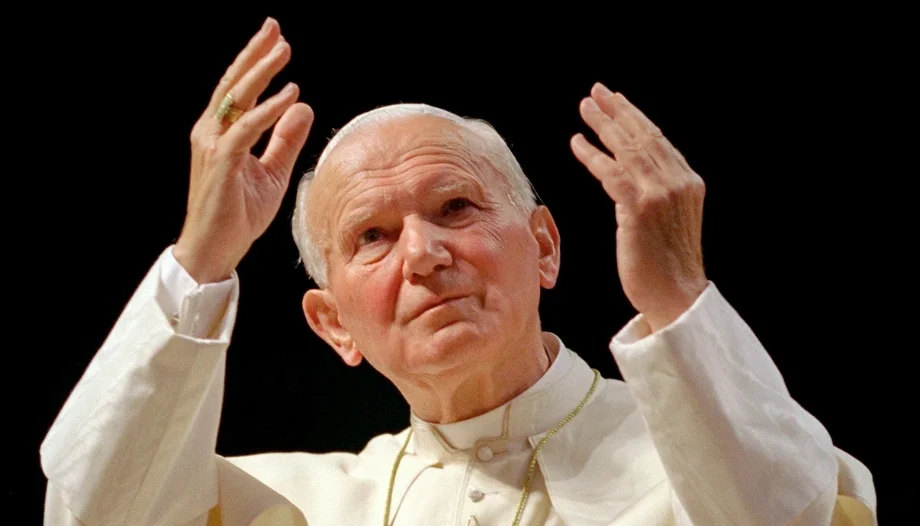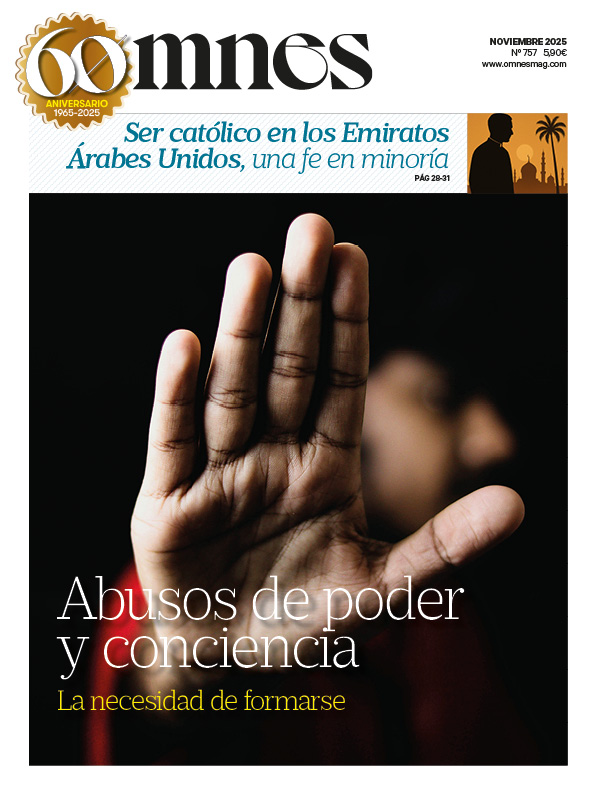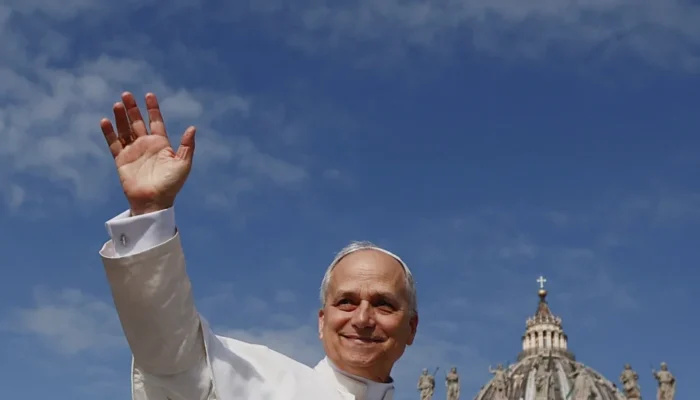It is no exaggeration to say that St. John Paul II's relationship with art was particularly close, to the point of being called “the artist pope” (just as he was also called “the philosopher pope”). This is largely due to his particular artistic sensibility, which he showed from a very young age and which he cultivated throughout his life, especially through poetry and drama.
Indeed, from the beginning of his career in the cultivation of the arts and of knowledge, Pope Wojtyła has sought to walk the path of beauty (the via pulchritudinis) as a means by which to arrive at the truth and the good of man. This was confirmed by Cardinal Giovanni Ravasi, president for many years of the Pontifical Council for Culture, referring to the last poetic work of the Polish pontiff, Roman TriptychWhen the Pope wrote these verses, behind him, culturally, not only his personal philosophical and theological itinerary, but also a path of height that he had never abandoned was unfolding: that of art. From poetry to theater, passing through admiration for artistic genius, he had lived uninterruptedly the search for beauty...“
It is often recurrent to turn to the Letter to the Artists (1999) as a primary source of St. John Paul II's thought on art. There is, however, a preceding text of singular importance. It is the spiritual exercises that the then Archbishop of Krakow addressed to a group of Polish artists in the Church of the Holy Cross in Krakow during Holy Week of 1962, published under the title of The Gospel and Art. Both texts are closely related and reveal the consolidation of a thought that has matured over time.
To these are added the speeches that, once in the See of Peter, Pope Wojtyła addressed in meetings with artists and representatives of the world of culture on the occasion of his pastoral trips, and other occasional interventions, such as the VIII. Meeting of Rimini (1987), the Jubilee of Artists (2000) or the speeches to the members of the Pontifical Academies and the Pontifical Council for the Cultural Heritage of the Church, which he himself had created. His main teachings on art and the search for beauty can be drawn from all this magisterium.
Art, transcendent opening to mystery
Following the classical conception, St. John Paul II understands beauty as the radiance of truth and good, particularly of the Supreme Truth and the Ultimate Good, which are identified with God. It is, therefore, as he himself defined it in 1962, a “divine sparkle”, which crystallizes in “a particular knowledge (...) not abstract, purely intellectual, but special”. In this way, he concludes, “beauty is the key to mystery and a call to the transcendent”. This is what he would emphasize in a meeting with artists in Venice (1985): “Art is (...) knowledge translated into strokes, images and sounds, symbols that the mere intellectual conception cannot recognize as projections on the mystery of life, because they are beyond their own limits: openings, therefore, to the depth, to the height, to the ineffable existence, paths that keep man free towards the mystery and that translate the longing that other words cannot express”.
In uniquely beautiful words, he expresses this same idea at the beginning of the Letter to the ArtistsNo one better than you, artists, genius builders of beauty, can intuit something of the pathos with which God, at the dawn of creation, contemplated the work of his hands. An echo of that sentiment has been reflected infinite times in the gaze with which you (...) have admired the work of your inspiration, discovering in it as it were the resonance of that mystery of creation with which God, the sole creator of all things, has wished in a certain way to associate you”. It is therefore a talent for capturing that divine halo we call beauty, to which the artist has access through a special sensitivity, in order to discover the true nature of things. Thus, artistic beauty “as a reflection of the Spirit of God” becomes “a cryptogram of mystery”.
The artist's vocation as a mediator between beauty and the world
If art, as a channel of expression and contemplation of beauty, allows a glimpse into the transcendent mystery, the artist -endowed with this singular sensitivity- becomes a privileged mediator or interpreter; or, following the simile of the cryptogram, a decryptor of such a mystery. Indeed, as Pope Wojtyła explains, “in ‘artistic creation’ man reveals himself more than ever ‘image of God,’” he participates in that “kind of divine flash which is the artistic vocation” through which “he can understand the work of the Creator and, together with it, receive in himself, in his creative fruitfulness, the imprint of gratuitous divine creativity.” It is thus understood that the artist lives “a peculiar relationship with beauty”, so that it can be concluded that “beauty is the vocation to which the Creator calls him with the gift of ‘artistic talent’”. In these ideas lies the high vocation and mission of the artist, called to be an interpreter of the ineffable mystery that surrounds God and his creative work.
St. John Paul II considers this function of mediation exercised by the artist between the earthly world and the transcendent reality to be so sublime - especially if it is a Christian artist - that he compares it to a kind of priesthood: “Both the individual and the community have to interpret the world of art and life, to shed light on the situation of their time, to understand the height and depth of existence. They need art to address that which is beyond the purely useful realm and which, therefore, promotes man. (...) According to a profound thought of Beethoven, the artist is called in some way to a priestly service.” Specifically, the artist/priest becomes a “proclaimer” or “recognizer” of the pulchrum divine and, next to it, of the verum and the bonum of the Being by Essence.
Here we see the sequence election-vocation-mission, which this holy Pope applies to the case of the artist: God calls artists to a particular mission, which is to recognize and reflect the divine beauty present in the world - and, together with it, the truth and goodness of creation - and for this he gives them a singular talent. “This talent,” he explains, “is a special good, a natural distinction. It is a gift from the Creator. A difficult gift. A gift for which one must pay with one's whole life. A gift that engenders a great responsibility". This mission implies an existential commitment, because the artist feels the responsibility to make it bear fruit. Whoever perceives in himself this kind of divine sparkle that is the artistic vocation," he adds, "at the same time realizes that he has a great responsibility to make it bear fruit. the obligation not to squander this talent, but to develop it in order to put it at the service of others and of all humanity”.
In Pope Wojtyła's opinion, this is not an easy path, because the artist faces two dangers that threaten the right deployment of this talent: on the one hand, the temptation to believe himself superior to God himself, to divinize his own works; on the other, to detach art from its true end, which is to reflect the truth and goodness of creation, that is, to detach artistic creation from the search for the truth about man himself and his happiness. From these considerations we can see the natural relationship between art and holiness - the need for the true artist to aspire to a life of spiritual fulfillment - to be able to create and manifest beauty, and to seek to contribute to the good of the world and of humanity. Beauty,“ concludes St. John Paul II, ”must be combined with goodness and holiness of life, so as to make the luminous face of God, good, admirable and just, shine forth in the world. In fact, his address on the occasion of the Jubilee of Artists in the year 2000 is “an invitation to practice the stupendous ‘art’ of sanctity".
Art, a path of evangelization and salvation
If art is a “revealer of transcendence” or a “cryptogram of mystery,” it carries within itself the capacity to lead to the existence of God. Already in the meditations he preached in 1962 to Polish artists in Krakow, the then Archbishop Wojtyła emphasized the efficacy of the via pulchritudinis to arrive at the knowledge of God. “Yes, indeed, the beauty of all creatures and of the works of nature and of the works of art is only a fragment, something limited, a symptom or a reflection, and there is nowhere its full, absolute version, then we must seek this absolute version of Beauty beyond creatures. Then we are on the path that leads us to the understanding that He exists. That Beauty, which is absolute and total, perfect from every point of view, is just Him”.
In a way, those words of the then Archbishop of Krakow were premonitory of the message that St. Paul VI wanted to address to artists immediately after the conclusion of the Second Vatican Council: “This world in which we live needs beauty in order not to fall into despair. St. John Paul II will echo this conciliar message on various occasions. Thus, for example, taking his cue from the well-known phrase found in a work by Dostoevsky - ”Beauty will save the world!“-, he pointed out before a group of artists in Salzburg (1988): ”In this context, beauty must be interpreted as the reflection of Beauty, of the splendor of God. In the face of the overwhelming reality of the contemporary world, one should really expand this phrase and say, “Goodness, goodness, love will save the world!‘ We Christians express with this the love of God, which in Jesus Christ has manifested itself in its salvific fullness and calls us to emulation.’ He will also allude to this power of art in the Letter to the Artists, in which he expresses his hope for the emergence of “a renewed ‘epiphany’ of beauty for our time,” which will awaken “that arcane longing for God”.
He would return to this “path of beauty” at the end of his pontificate in an address to the members of the Pontifical Academies six months before his death in November 2004, in which he would define the via pulchritudinis “The Pope said, ”as a privileged itinerary for the encounter between the Christian faith and the cultures of our time, and as a valuable instrument for the formation of the younger generations“. And he urged: ”If the witness of Christians is to influence today's society, it must be nourished by beauty so that it becomes an eloquent transparency of the beauty of God's love“. This is the only way to promote ”a new Christian humanism, capable of walking the path of authentic beauty and of pointing it out to everyone as a path of dialogue and peace among peoples". In fact, a couple of years later, the Pontifical Council for Culture would take up this invitation and prepare an extensive document, full of thought-provoking reflections, entitled The “Via Pulchritudinis”, a path of evangelization and dialogue.
At this point, and within this salvific dimension of art, St. John Paul II distinguishes two aspects that constitute two sides of the same coin: the intimate connection that exists between beauty, truth and good; and, consequently, the efficacy of art as a vehicle of catechesis. Regarding the first aspect, in a meeting with artists, he affirmed: “As the ancients teach us, the beautiful, the true and the good are united by an indissoluble bond”. This ontological triad, which deeply permeates all created reality, challenges the talent of the artist, who, thanks to divine inspiration, is capable of capturing and interpreting these signals of transcendence emitted by the created universe in all its splendor. This is his mediating mission, as we have seen: a mediation that reveals the triple divine imprint present in the world and that attracts the human mind and heart through beauty. With beautiful words Pope Wojtyła himself expresses it in his Letter to the Artists, The “authentic inspiration has a certain vibration of that ‘breath’ with which the creative Spirit permeated from the beginning the work of creation”It consists of “a kind of inner illumination, which unites at the same time the tendency to the good and the beautiful, awakening in him the energies of the mind and the heart, and thus making him fit to conceive the idea and give it form in the work of art”.
Herein lies the foundation of the catechetical efficacy of art, to which St. John Paul II has referred on various occasions. Specifically, he uses the expression “catechetical mediation,” which he takes from St. Gregory the Great, and which is based on this capacity that art possesses to reveal those glimpses of God's presence in the world. In fact,“ says this holy Pope in his Letter to the Artists- the Son of God, by becoming man, has introduced into the history of humanity all the evangelical richness of truth and goodnessand with it he has also stated a new dimension of beauty, of which the Gospel message is replete”. Hence, paraphrasing some artists and writers, he has referred to Sacred Scripture as a kind of “immense vocabulary” (P. Claudel) and “iconographic atlas” (M. Chagall) that has served as an inspiration to cultivators of the most diverse arts. In short, artists who recognize in themselves this talent will be able to offer “works of art that will open the eyes, ears and hearts of people in a new way, whether they are believers or seekers.
“In the name of Beauty.”
It can be concluded that Karol Wojtyła/John Paul II has contemplated, practiced and traveled the. via pulchritudinis since his youth, while reflecting on it as well. At the age of just nineteen, he headed one of the letters addressed to his rhapsodic drama teacher, Mieczysław Klotarczyk, in a most eloquent way: “I greet you with the Name of Beauty, which is the profile of God, the cause of Christ and the cause of Poland.” From that moment on, he would cultivate the arts of the word (poetry and theater) all his life, culminating in the publication, at the end of his pontificate, of his poetic legacy Roman Triptych.
It is not surprising that the so-called “poet pope” developed a singular sensitivity towards the artistic and cultural world, and that he even developed his own ontology of art as an opening towards transcendence. Art thus becomes a “cryptogram of mystery”, a form of knowledge, a manifestation of the divine presence in the world. A mystery that the artist is called to unveil through his peculiar vocation. A mystery that is incarnated through the expression of beauty, converted into a path of salvific revelation (via pulchritudinis).
From his place in the Father's House, this holy Pope continues to remind artists of all times: “May your art contribute to the consolidation of an authentic beauty which, almost like a flash of the Spirit of God, transfigures matter, opening souls to a sense of the eternal.
Priest. Doctor in Audiovisual Communication and Moral Theology. Professor of the Core Curriculum Institute of the University of Navarra.








